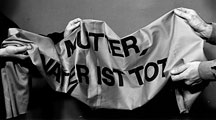|
1987, Video
MUTTER VATER IST TOT
Raskin
About: Mother Father is Dead
by Colin Hood, Gabrielle Finnane
ln a work from 1987, Mother Father is Dead, Rotraut Pape and Andreas Coerper reworked a Dallas story in a scene like some video clinic of the future, a technocratic vision of soap opera. Key elements—talking heads, stealthy sideways glances, confessional language of magazine psychology, hyperbolic musical punctuation, filming within a studio space, flashbacks and dissolves—played on a stylistic crossover between TV soap and some modernist polemic against action, realist mise-en-scene and staging. The archetypal story involves a father who goes missing in an airplane accident, is found by natives, suffers amnesia, reappears wearing dresses and wigs, returns to live near his family disguised as a ranchhand. The mother believes this is her husband, the three sons consider him a liar and a crook. The mother recounts the story, the sons take up the thread and in a tightly structured seven minutes a story unravels in which each teller of the tale in turn becomes the 'l' of the flashback, a pseudo-memory recounted to the mother by a pseudo-father whose 'return from death' triggered the story in the first place. In an open-ended conclusion the sons decide to expose the ranchhand/father in the hotel as a liar and a crook and while the mother pleads with them 'no violence', news footage of a policeman breaking down a door plays in a scratch repetition.
Pape in brown silk and white pearls playing the mother, a floral background for a nostalgic photo, strange wigs superimposed over the performers faces standing in for the amnesiac father, optical screens and backgrounds covered in mathematical formulae, all combined to reconstitute the rich artifice of a formulaic story. The deep colours of the studio backgrounds, the white studio earplugs evident in the actors' ears, the changing mise-en -scène of the clothing imparted an ambiguous air to the presentation.
The shuttling of the story between different performers takes a different slant in the trilogy which commenced with Smokenights and You Have No Heart. The trilogy traces the permutations of soap operatic sentences through an inventive variety of forms—unravelling the pictorial and plastic nature of their language. (Colin Hood, Gabrielle Finnane)
RP There's a story in it but it's twisted around a bit—someone burnt in an accident who has lost his face, voice and memory, then fixed up by plastic surgery matching a picture they found in his pocket—a picture of his wife. When his consciousness comes back, he finds his family, but they thought he was dead and they don't recognize him, because he is a woman now. Some 'real Dallas fans' might recall the story, but we doubled it, giving a female face to the father, using a woman with a wig. It's a work on memory and identity with questions like: was it really me, or do l only think so, because l've heard this story so often?
in:
From the Supermarket of Sentences
Out Of The Intermix. Audience, genre, new media
West 6/7 1993
Faculty of Visual and Performing Arts, University of Western Sydney
ISBN 1 86341 123 2 ISSN 1038 8565
|
